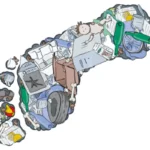Bridging the Gap: The Loss and Damage Fund’s Pivotal Role in Climate Financing

“The climate crisis does not discriminate; it impacts us all. However, the burden is disproportionately carried by those who contributed least to its creation. Now, the Loss and Damage Fund has become a beacon of hope, aiming to rectify historical injustices and ensure a sustainable future for all.”
On the opening day of the COP28 climate conference in Dubai, the world witnessed a landmark moment as the Loss and Damage Fund, a financial lifeline for nations grappling with the severe consequences of climate change, was officially launched. The initial commitment of $475 million, with contributions from the UAE, the European Union, the US, and Japan, marks a significant step towards addressing the growing challenges faced by vulnerable countries.
Understanding the Loss and Damage Fund
The Loss and Damage Fund is a global financial package designed to facilitate the rescue and rehabilitation of countries experiencing the cascading effects of climate change. It represents a form of compensation from affluent nations, whose industrial activities have significantly contributed to global warming, to less developed nations facing the brunt of rising sea levels, floods, droughts, cyclones, and more. The term “loss and damage” encompasses both economic and non-economic impacts, reflecting the diverse ways climate change affects communities, livelihoods, biodiversity, and cultural identities.
Adelle Thomas, a lead author of the Intergovernmental Panel on Climate Change (IPCC’s) 2022 report, emphasizes that loss and damage can be categorized into economic, quantifiable impacts, and non-economic, more abstract impacts. This distinction recognizes the profound and often immeasurable effects of climate change on communities.
The Industrial Era’s Toll on the Planet
The roots of the current climate crisis track back to the Industrial Era, starting in 1850, during which Earth’s natural mechanisms for greenhouse gas regulation were disrupted. The responsibility for 65 per cent of historical emissions lies with the US, the UK, the EU, Russia, Canada, Japan, and Australia combined. In stark contrast, India, responsible for only 4 per cent of historical emissions, and China, the largest emitter in recent years, grapple with the repercussions of global warming.
Research indicates that 55 vulnerable countries have suffered a staggering $525 billion in climate crisis-related losses over the past two decades. This number is projected to increase to $580 billion annually by 2030. The impact of global warming is unevenly distributed, with developing nations, particularly socially and financially vulnerable sections within them, bearing the brunt.
The Birth of the Loss and Damage Fund
The Loss and Damage Fund’s genesis can be traced back over 30 years, with a persistent call for affluent nations to acknowledge their historical role in pollution. The formal establishment of the fund occurred during COP19 in 2013, with subsequent developments and challenges, including the establishment of the Santiago Network for Loss and Damage at COP25 and discussions on operationalization at COP26.
COP27, held in Sharm el-Sheikh, Egypt, in 2022, saw intense negotiations that led to the creation of the Loss and Damage Fund. A Transitional Committee was formed to navigate the operationalization of the fund, with TC4 facing challenges related to the fund’s management at the World Bank, the principle of common but differentiated responsibilities (CBDR), climate reparations, and eligibility criteria for funds. TC5, whose recommendations were forwarded to COP28, aims to pave the way for the fund’s effective functioning.
Challenges and Implications
Despite progress, challenges persist in the operationalization of the Loss and Damage Fund. Developed nations, notably the US, remain hesitant to commit as primary donors. The lack of clarity regarding the fund’s size and structure, coupled with diplomatic breakdowns, raises concerns about the global community’s ability to address climate change collectively.
The impasse over the fund has far-reaching implications, threatening climate justice, exacerbating humanitarian crises, and deepening the divide between developed and developing nations. Security implications arise as climate-induced instability leads to conflicts and tensions, risking spillover effects and creating additional challenges.
The Way Forward
To ensure the Loss and Damage Fund fulfils its mission, there must be sustained and active commitment from developed nations, with primary donors stepping forward with robust financial commitments to address the irreversible consequences of climate change. Simultaneously, advocacy for transparent discussions on the fund’s size, operational guidelines, and allocation mechanisms is crucial, as clarity and accountability are paramount for building trust and ensuring the fund serves its intended purpose. Inclusive diplomacy plays a pivotal role, necessitating open dialogues that genuinely address the concerns of developing nations, fostering collaboration for effective climate action and the resolution of global issues. Moreover, proactive addressing of security implications arising from climate-induced instability is vital, involving the implementation of measures to tackle humanitarian crises and support vulnerable communities, contributing to a more stable and sustainable world.
In conclusion, the Loss and Damage Fund emerges as a beacon of hope amid the escalating climate crisis. As the international community navigates the challenges of operationalizing the fund, it is essential to remember the principles of fairness, justice, and shared responsibility. By acting collectively and addressing the concerns of all nations, we can pave the way for a sustainable future and mitigate the irreversible consequences of climate change!
 About the Authors:
About the Authors:
Dr Fauzia Khan, Member of Parliament, Rajya Sabha; Dr Kaviraj Singh, Founder and Managing Director, Earthood





















































































































































































































































































































































































































































































































































































































































































































































































































































